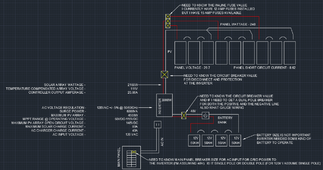hepheastus
New Member
I am having immense trouble finding what fuses and breakers I need.
It feels like there is a bit of knowledge gap and assumed knowledge in some of the resources I have been able to gather.
I have drawn the image below, the spots in yellow are my knowledge gaps and final hurdles before I can complete this system.

Main goal of this system is:
Having mostly reliable power for work from home during day-time hours.
Offsetting power consumption of network rack (500w always on power according to smart meter from electric company)
I had planned 10x 240w panels, 5 in series, 2 in parallel but recently I found it's operating voltage would have been too much (186) than it's allowed 145v (thanks to Will in that video where he had two arrays going to a Growatt, and in testing both, finding out one was too much and the other within spec).
So I had trimmed a panel down and did 3 in series 3 in parallel giving me 111v.
I also had planned on a running this with no battery but I have purchased the wrong model. In researching this I saw Will had mentioned in a thread about this specific model to just get any battery that will amount to 48volts.
I have also purchased this breaker for the battery (https://www.amazon.com/dp/B089TNNRS6) after searching what was recommended in the manual but when receiving the breaker and then watching a lot of videos I saw the symbol on it was AC and now I'm questioning my progress.
I have also purchased this breaker housing for the battery breaker (https://www.amazon.com/dp/B0C5WQ8JGR) so I would like something that could go into it but if recommended something else I am not too worried about returning it.
Components of my system so far -
Solar Panels - Trina 240W Solar Panel (x9) https://www.solarelectricsupply.com/trina-solar-tsm-240pa05-solar-panels
The Solar Inverter - Growatt SPF 3000TL LVM (48V version) https://en.growatt.com/products/spf-2000-5000tl-hvm(lvm)
Batteries - Timeusb 12V 50Ah LifePO4 (x4) https://www.timeusbpower.com/products/12v-50ah-pro-lifepo4-battery
Please, any help to get me past the finish line would be greatly appreciated.
I would love to get this nearly two year project in the rear view mirror.
It feels like there is a bit of knowledge gap and assumed knowledge in some of the resources I have been able to gather.
I have drawn the image below, the spots in yellow are my knowledge gaps and final hurdles before I can complete this system.

Main goal of this system is:
Having mostly reliable power for work from home during day-time hours.
Offsetting power consumption of network rack (500w always on power according to smart meter from electric company)
I had planned 10x 240w panels, 5 in series, 2 in parallel but recently I found it's operating voltage would have been too much (186) than it's allowed 145v (thanks to Will in that video where he had two arrays going to a Growatt, and in testing both, finding out one was too much and the other within spec).
So I had trimmed a panel down and did 3 in series 3 in parallel giving me 111v.
I also had planned on a running this with no battery but I have purchased the wrong model. In researching this I saw Will had mentioned in a thread about this specific model to just get any battery that will amount to 48volts.
I have also purchased this breaker for the battery (https://www.amazon.com/dp/B089TNNRS6) after searching what was recommended in the manual but when receiving the breaker and then watching a lot of videos I saw the symbol on it was AC and now I'm questioning my progress.
I have also purchased this breaker housing for the battery breaker (https://www.amazon.com/dp/B0C5WQ8JGR) so I would like something that could go into it but if recommended something else I am not too worried about returning it.
Components of my system so far -
Solar Panels - Trina 240W Solar Panel (x9) https://www.solarelectricsupply.com/trina-solar-tsm-240pa05-solar-panels
The Solar Inverter - Growatt SPF 3000TL LVM (48V version) https://en.growatt.com/products/spf-2000-5000tl-hvm(lvm)
Batteries - Timeusb 12V 50Ah LifePO4 (x4) https://www.timeusbpower.com/products/12v-50ah-pro-lifepo4-battery
Please, any help to get me past the finish line would be greatly appreciated.
I would love to get this nearly two year project in the rear view mirror.
Last edited:


